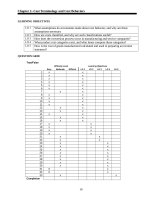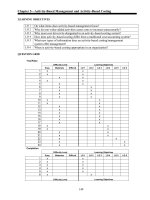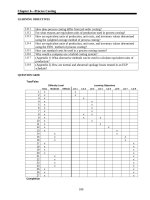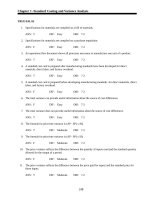Fundamental of management essential concepts and application 8e by robbin decenzo couter
Bạn đang xem bản rút gọn của tài liệu. Xem và tải ngay bản đầy đủ của tài liệu tại đây (16.83 MB, 499 trang )
®
MyManagementLab
MyManagementLab is an online assessment and preparation
solution for courses in Principles of Management, Human
Resources, Strategy, and Organizational Behavior that helps
you actively study and prepare material for class. Chapterby-chapter activities, including study plans, focus on what
you need to learn and to review in order to succeed.
Visit www.mymanagementlab.com to learn more.
FUNDAMENTALS
OF MANAGEMENT
ESSENTIAL CONCEPTS
AND
APPLICATIONS
This page intentionally left blank
FUNDAMENTALS
OF MANAGEMENT 8e
ESSENTIAL CONCEPTS
AND
APPLICATIONS
STEPHEN P. ROBBINS
San Diego State University
DAVID A. DECENZO
Coastal Carolina University
MARY COULTER
Missouri State University
Boston Columbus Indianapolis New York San Francisco Upper Saddle River
Amsterdam Cape Town Dubai London Madrid Milan Munich Paris Montréal Toronto
Delhi Mexico City Sao Paulo Sydney Hong Kong Seoul Singapore Taipei Tokyo
Editorial Director: Sally Yagan
Senior Acquisitions Editor: Kim Norbuta
Editorial Project Manager: Claudia Fernandes
Director of Marketing: Maggie Moylan
Senior Marketing Manager: Nikki Ayana Jones
Marketing Assistant: Ian Gold
Senior Managing Editor: Judy Leale
Production Project Manager: Kelly Warsak
Senior Operations Supervisor: Arnold Vila
Operations Specialist: Cathleen Petersen
Creative Director: Blair Brown
Senior Art Director: Kenny Beck
Text Designer: Michael Fruhbeis
Cover Designer: Michael Fruhbeis
Cover Art: LCI Design
Manager, Rights and Permissions: Hessa Albader
Medial Project Manager, Production: Lisa Rinaldi
Senior Media Project Manager: Denise Vaughn
Full-Service Project Management: Sharon Anderson/Bookmasters, Inc.
Composition: Integra Software Services
Printer/Binder: Courier/Kendallville
Cover Printer: Lehigh-Phoenix Color
Text Font: 10/12 Times
Credits and acknowledgments borrowed from other sources and reproduced, with permission, in this textbook
appear on appropriate page within text.
Microsoft® and Windows® are registered trademarks of the Microsoft Corporation in the U.S.A. and other
countries. Screen shots and icons reprinted with permission from the Microsoft Corporation. This book is not
sponsored or endorsed by or affiliated with the Microsoft Corporation.
Copyright © 2013, 2011, 2008, 2005, 2004 Pearson Education, Inc., publishing as Prentice Hall, One Lake
Street, Upper Saddle River, New Jersey 07458. All rights reserved. Manufactured in the United States of
America. This publication is protected by Copyright, and permission should be obtained from the publisher prior
to any prohibited reproduction, storage in a retrieval system, or transmission in any form or by any means,
electronic, mechanical, photocopying, recording, or likewise. To obtain permission(s) to use material from this
work, please submit a written request to Pearson Education, Inc., Permissions Department, One Lake Street,
Upper Saddle River, New Jersey 07458, or you may fax your request to 201-236-3290.
Many of the designations by manufacturers and seller to distinguish their products are claimed as trademarks.
Where those designations appear in this book, and the publisher was aware of a trademark claim, the designations
have been printed in initial caps or all caps.
Library of Congress Cataloging-in-Publication Data
Robbins, Stephen P.,
Fundamentals of management: essential concepts and applications / Stephen P. Robbins,
David A. DeCenzo, Mary Coulter. — 8th ed.
p. cm.
Includes bibliographical references and index.
ISBN 978-0-13-262053-6
1. Management. I. DeCenzo, David A. II. Coulter, Mary K. III. Title.
HD31.R5643 2013
658—dc23
2011043635
10 9 8 7 6 5 4 3 2 1
ISBN 10:
0-13-262053-7
ISBN 13: 978-0-13-262053-6
To my wife, Laura
Steve
To my family who continue to help me understand what
life is about, who are there through thick and thin, and
who demonstrate what is good about people today. To
Terri, Mark, Meredith, Gabriella, and Natalie, thank you
for making me the person I am today.
Dave
To Brooklynn...my sweet baby girl!
Mary
v
This page intentionally left blank
Brief Contents
Part 1 Introduction 2
Chapter 1
Managers and Management 2
History
Module
Chapter 2
Chapter 3
A Brief History of Management’s Roots 21
The Management Environment 28
Integrative Managerial Issues 46
Part 2 Planning 70
Chapter 4
Foundations of Decision Making 70
Quantitative
Module
Chapter 5
Quantitative Decision-Making Aids 94
Foundations of Planning 104
Part 3 Organizing 130
Chapter 6
Chapter 7
Organizational Structure and Design 130
Managing Human Resources 160
Career
Module
Chapter 8
Building Your Career 193
Managing Change and Innovation 198
Part 4 Leading 220
Chapter 9
Chapter 10
Chapter 11
Chapter 12
Chapter 13
Foundations of Individual Behavior 220
Understanding Groups and Managing Work Teams 248
Motivating and Rewarding Employees 272
Leadership and Trust 298
Managing Communication and Information 326
Part 5 Controlling 346
Chapter 14
Chapter 15
Foundations of Control 346
Operations Management 368
Entrepreneurship
Module
Managing Entrepreneurial Ventures 392
Your Turn to Be a Manager 402
Name/Organization Index 461
Glindex (combined subject index and glossary) 465
vii
This page intentionally left blank
Contents
A Short Note to Students
xv
Preface
xvii
About the Authors
xxiii
Contemporary Approaches 26
Endnotes 27
Chapter 2
Part 1 Introduction 2
Chapter 1
Managers and Management 2
Who Are Managers and Where Do They Work? 4
What Three Characteristics Do All Organizations
Share? 4
How Are Managers Different from Nonmanagerial
Employees? 5
What Titles Do Managers Have? 5
Right or Wrong? 5
What Is Management? 6
From the Past to the Present | Origins of managers/
management 7
What Do Managers Do? 8
What Are the Four Management
Functions? 8
What Are Management Roles? 9
What Skills and Competencies Do Managers
Need? 11
Is the Manager’s Job Universal? 12
Technology and the Manager’s Job | Is It Still
Managing When What You’re Managing Are
Robots? 12
and the Survey Says . . . 14
Why Study Management? 15
What Factors Are Reshaping and Redefining
Management? 16
Why Are Customers Important to the Manager’s
Job? 16
Why Is Innovation Important to the Manager’s
Job? 17
Review
Chapter Summary 18 • Understanding the
Chapter 18 • • Endnotes 19
Your Turn to Be a Manager 402
The Management
Environment 28
What Is the External Environment and Why Is It
Important? 30
How Has the Economy Changed? 31
From the Past to the Present | Omnipotent/
symbolic views of management 32
What Role Do Demographics Play? 33
Technology and the Manager’s Job | Changing and
Improving the Way Managers Manage 33
How Does the External Environment Affect
Managers? 34
Right or Wrong? 36
What Is Organizational Culture and Why Is It
Important? 38
What Is Organizational Culture? 38
How Can Culture Be Assessed? 38
Where Does an Organization’s Culture Come
From? 39
How Do Employees Learn the Culture? 40
and the Survey Says . . . 40
How Does Organizational Culture Affect
Managers? 41
How Does Culture Affect What Employees Do? 41
How Does Culture Affect What
Managers Do? 41
Review
Chapter Summary 43 • Understanding the
Chapter 43 • • Endnotes 44
Your Turn to Be a Manager 406
Chapter 3
Integrative Managerial
Issues 46
What Is Globalization and How Does It Affect
Organizations? 48
What Does It Mean to Be “Global”? 48
What Are the Different Types of Global
Organizations? 49
History Module
How Do Organizations Go Global? 50
A Brief History of Managements Roots 21
What Do Managers Need to Know About
Managing in a Global Organization? 51
Early Management 21
From the Past to the Present | Geert Hofstede’s
study of cultural environments 52
Classical Approaches 22
Behavioral Approach 23
Quantitative Approach 24
What Does Society Expect from Organizations
and Managers? 54
ix
x
CONTENTS
How Can Organizations Demonstrate Socially
Responsible Actions? 54
How Do Nonprogrammed Decisions Differ from
Programmed Decisions? 82
Should Organizations Be Socially Involved? 55
and the Survey Says . . . 56
How Are Problems, Types of Decisions, and
Organizational Level Integrated? 83
What Is Sustainability and Why Is It Important? 56
and the Survey Says . . . 83
What Factors Determine Ethical and Unethical
Behavior? 56
In What Ways Can Ethics Be Viewed? 57
How Can Managers Encourage Ethical
Behavior? 58
What Is Today’s Workforce Like and How Does It
Affect the Way Organizations Are Managed? 59
What Decision-Making Conditions Do Managers
Face? 83
How Do Groups Make Decisions? 84
What Are the Advantages of Group Decision
Making? 84
What Are the Disadvantages of Group Decision
Making? 85
What Is Workplace Diversity? 60
When Are Groups Most Effective? 85
What Types of Diversity Are Found in
Workplaces? 60
Right or Wrong? 86
Right or Wrong? 61
How Are Organizations and Managers Adapting
to a Changing Workforce? 63
Review
Chapter Summary 65 • Understanding the
Chapter 65 • Your Turn to Be a Manager 000
• Endnotes 67
Your Turn to Be a Manager 409
How Can You Improve Group Decision
Making? 86
What Contemporary Decision-Making Issues Do
Managers Face? 87
How Does National Culture Affect Managers’
Decision Making? 87
Why Is Creativity Important in Decision
Making? 88
Review
Chapter Summary 90 • Understanding the
Chapter 91 • • Endnotes 91
Part 2 Planning 70
Chapter 4
Foundations of Decision
Making 70
How Do Managers Make Decisions? 72
What Defines a Decision Problem? 72
What Is Relevant in the Decision-Making
Process? 73
Your Turn to Be a Manager 412
Quantitative Module
Quantitative Decision-Making Aids
Payoff Matrices 94
Decision Trees 95
How Does the Decision Maker Weight the Criteria
and Analyze Alternatives? 73
Break-Even Analysis 96
What Determines the Best Choice? 74
Linear Programming 99
What Happens in Decision Implementation? 75
Queuing Theory 100
What Is the Last Step in the Decision Process? 75
Economic Order Quantity Model 101
What Common Errors Are Committed in the
Decision-Making Process? 75
Endnotes 103
What Are Three Approaches Managers Can Use to
Make Decisions? 77
What Is the Rational Model of Decision Making? 78
Technology and the Manager’s Job | Making Better
Decisions with Technology 78
From the Past to the Present | Herbert A. Simon’s
study of satisficing 79
What Is Bounded Rationality? 79
What Role Does Intuition Play in Managerial
Decision Making? 80
What Types of Decisions and Decision-Making
Conditions Do Managers Face? 81
Ratio Analysis 97
Chapter 5
Foundations of Planning 104
What Is Planning and Why Do Managers Need to
Plan? 106
Why Should Managers Formally Plan? 106
What Are Some Criticisms of Formal
Planning? 107
Does Formal Planning Improve Organizational
Performance? 108
What Do Managers Need to Know About Strategic
Management? 108
What Is Strategic Management? 108
How Do Problems Differ? 81
Why Is Strategic Management Important? 108
How Does a Manager Make Programmed
Decisions? 81
What Are the Steps in the Strategic Management
Process? 109
CONTENTS
What Strategies Do Managers Use? 111
Right or Wrong? 113
What Contemporary Organizational Designs
Can Managers Use? 145
What Strategic Weapons Do Managers Have? 115
and the Survey Says . . . 148
Technology and the Manager’s Job | IT and
Strategy 116
How Do Managers Set Goals and Develop
Plans? 117
What Types of Goals Do Organizations Have and
How Do They Set Those Goals? 117
From the Past to the Present | Peter Drucker
and MBO 119
What Types of Plans Do Managers Use and How
Do They Develop Those Plans? 120
and the Survey Says . . . 122
What Contemporary Planning Issues Do Managers
Face? 123
How Can Managers Plan Effectively in Dynamic
Environments? 123
How Can Managers Use Environmental
Scanning? 124
Review
Chapter Summary 125 • Understanding the
Chapter 125 • • Endnotes 126
Your Turn to Be a Manager 416
Part 3 Organizing 130
What Are Today’s Organizational Design
Challenges? 149
How Do You Keep Employees Connected? 149
How Do Global Differences Affect Organizational
Structure? 149
Technology and the Manager’s Job | The Changing
World of Work 149
How Do You Build a Learning Organization? 150
How Can Managers Design Efficient and Effective
Flexible Work Arrangements? 151
Review
Chapter Summary 154 • Understanding the
Chapter 154 • Endnotes 156
Your Turn to Be a Manager 420
Chapter 7
Managing Human
Resources 160
What Is the Human Resource Management Process
and What Influences It? 162
What Is the Legal Environment of HRM? 163
From the Past to the Present | Hugo Munsterberg
and I/O Psychology 165
How Do Managers Identify and Select Competent
Employees? 166
What Is Employment Planning? 166
Organizational Structure and
Design 130
How Do Organizations Recruit Employees? 168
What Are the Six Key Elements in Organizational
Design? 132
How Do Managers Select Job Applicants? 169
Chapter 6
What Is Work Specialization? 132
What Is Departmentalization? 134
What Are Authority and Responsibility? 135
How Does a Manager Handle Layoffs? 168
How Are Employees Provided with Needed Skills
and Knowledge? 173
How Are New Hires Introduced to the
Organization? 173
What Is Span of Control? 139
Technology and the Manager’s Job | Digital HR
Right or Wrong? 140
What Is Employee Training? 174
How Do Centralization and Decentralization
Differ? 140
What Is Formalization? 140
What Contingency Variables Affect Structural
Choice? 141
How Is a Mechanistic Organization Different from
an Organic Organization? 141
How Does Strategy Affect Structure? 142
How Does Size Affect Structure? 143
How Does Technology Affect Structure? 143
From the Past to the Present | Joan Woodward's
study of technology and structure 143
How Does the Environment Affect
Structure? 144
What Are Some Common Organizational
Designs? 144
What Traditional Organizational Designs Can
Managers Use? 144
173
How Do Organizations Retain Competent,
High-Performing Employees? 176
What Is a Performance Management
System? 176
What Happens If an Employee’s Performance Is
Not Up to Par? 178
and the Survey Says . . . 178
How Are Employees Compensated? 178
What Contemporary HRM Issues Face
Managers? 180
How Can Managers Manage Downsizing? 180
How Can Workforce Diversity Be
Managed? 181
Right or Wrong? 182
What Is Sexual Harassment? 182
What Is Workplace Spirituality? 184
How and Why Are Organizations Controlling
HR Costs? 185
xi
xii
CONTENTS
Review
Chapter Summary 187 • Understanding the
Chapter 187 • Endnotes 188
Your Turn to Be a Manager 423
What Role Do Attitudes Play in Job
Performance? 224
What Are the Three Components of an
Attitude? 224
What Attitudes Might Employees Hold? 224
Career Module
Do Individuals’ Attitudes and Behaviors Need to Be
Consistent? 225
Building Your Career 193
What Is Cognitive Dissonance Theory? 225
What Was Career Development Like Historically? 193
and the Survey Says . . . 226
What Is Career Development Like Now? 193
How Can an Understanding of Attitudes Help
Managers Be More Effective? 226
How Can I Have a Successful Career? 194
Chapter 8
Managing Change and
Innovation 198
What Is Change and How Do Managers Deal
with It? 200
What Do Managers Need to Know About
Personality? 227
Can Personality Predict Behavior? 227
Right or Wrong? 230
Can Personality Traits Predict Practical
Work-Related Behaviors? 230
Why Do Organizations Need to Change? 201
How Do We Match Personalities and Jobs? 231
Who Initiates Organizational Change? 202
How Does Organizational Change Happen? 202
Do Personality Attributes Differ Across
Cultures? 231
From the Past to the Present | Kurt Lewin’s study of
change 204
How Can an Understanding of Personality Help
Managers Be More Effective? 233
How Do Managers Manage Resistance to
Change? 206
What Is Perception and What Influences It? 233
What Influences Perception? 233
Why Do People Resist Organizational Change? 206
How Do Managers Judge Employees? 234
and the Survey Says . . .
How Can an Understanding of Perception Help
Managers Be More Effective? 236
206
What Are Some Techniques for Reducing
Resistance to Organizational Change? 206
What Reaction Do Employees Have to
Organizational Change? 207
How Do Learning Theories Explain Behavior? 237
What Is Operant Conditioning? 237
What Is Stress? 208
From the Past to the Present | Classical and operant
conditioning 238
What Are the Symptoms of Stress? 208
What Is Social Learning Theory? 238
What Causes Stress? 208
How Can Managers Shape Behavior? 239
Right or Wrong? 210
How Can an Understanding of Learning Help
Managers Be More Effective? 239
How Can Stress Be Reduced? 210
How Can Managers Encourage Innovation in an
Organization? 211
How Are Creativity and Innovation Related? 211
What’s Involved in Innovation? 212
How Can a Manager Foster Innovation? 212
What Contemporary OB Issues Face Managers? 240
How Do Generational Differences Affect the
Workplace? 240
How Do Managers Deal with Negative Behavior in
the Workplace? 241
Review
Review
Chapter Summary 215 • Understanding the
Chapter 215 • Endnotes 217
Your Turn to Be a Manager 426
Chapter Summary 242 • Understanding the
Chapter 243 • Endnotes 243
Your Turn to Be a Manager 431
Chapter 10
Part 4 Leading 220
Chapter 9
Foundations of Individual
Behavior 220
What Are the Focus and Goals of Organizational
Behavior? 222
What Is the Focus of OB? 222
What Are the Goals of Organizational
Behavior? 223
Understanding Groups and
Managing Work Teams 248
What Is a Group and What Stages of Development
Do Groups Go Through? 250
What Is a Group? 250
What Are the Stages of Group
Development? 251
and the Survey Says . . . 252
What Are the Major Concepts of Group
Behavior? 252
CONTENTS
What Are Roles? 252
Right or Wrong? 253
How Do Norms and Conformity Affect Group
Behavior? 253
From the Past to the Present | Solomon Asch’s study
of conformity 254
How Can Managers Design Appropriate Rewards
Programs? 289
Review
Chapter Summary 292 • Understanding the
Chapter 293 • Endnotes 293
Your Turn to Be a Manager 441
What Is Status and Why Is It Important? 254
Does Group Size Affect Group Behavior? 255
Are Cohesive Groups More Effective? 255
How Are Groups Turned into Effective Teams? 256
Are Work Groups and Work Teams the Same? 256
Chapter 12
Leadership and Trust 298
Who Are Leaders, and What Is Leadership? 300
What Do Early Leadership Theories Tell Us About
Leadership? 300
What Are the Different Types of Work Teams? 257
What Traits Do Leaders Have? 300
Technology and the Manager’s Job | IT and
Teams 258
What Behaviors Do Leaders Exhibit? 301
What Makes a Team Effective? 259
How Can a Manager Shape Team Behavior? 262
What Current Issues Do Managers Face in
Managing Teams? 263
From the Past to the Present | Ohio State and
Michigan studies of leader behavior 303
What Is the Managerial Grid? 304
What Do the Contingency Theories of Leadership
Tell Us? 304
What’s Involved with Managing Global
Teams? 263
What Was the First Comprehensive Contingency
Model? 304
When Are Teams Not the Answer? 265
How Do Followers’ Willingness and Ability Influence
Leaders? 306
Review
Chapter Summary 266 • Understanding the
Chapter 267 • Endnotes 267
Your Turn to Be a Manager 436
and the Survey Says . . . 308
How Participative Should a Leader Be? 308
How Do Leaders Help Followers? 308
What Is Leadership Like Today? 310
Chapter 11
Motivating and Rewarding
Employees 272
What Is Motivation? 274
and the Survey Says . . . 274
What Do the Early Theories of Motivation Say? 275
What Do the Four Contemporary Views of
Leadership Tell Us? 310
Right or Wrong? 313
What Issues Do Today’s Leaders Face? 314
What Is Maslow’s Hierarchy of Needs Theory? 275
Technology and the Manager’s Job | Virtual
Leadership 315
What Are McGregor’s Theory X and Theory Y? 276
Why Is Trust the Essence of Leadership? 317
What Is Herzberg’s Two-Factor Theory? 276
From the Past to the Present | Frederick Herzberg
and job design 278
What Is McClelland’s Three-Needs Theory? 278
How Do the Contemporary Theories Explain
Motivation? 279
What Is Goal-Setting Theory? 279
How Does Job Design Influence Motivation? 280
What Is Equity Theory? 282
A Final Thought Regarding Leadership 318
Review
Chapter Summary 319 • Understanding the
Chapter 320 • Endnotes 320
Your Turn to Be a Manager 445
Chapter 13
Managing Communication and
Information 326
How Do Managers Communicate Effectively? 328
Right or Wrong? 283
How Does the Communication Process Work? 328
How Does Expectancy Theory Explain
Motivation? 283
Are Written Communications More Effective Than
Verbal Ones? 330
How Can We Integrate Contemporary Motivation
Theories? 285
Is the Grapevine an Effective Way to
Communicate? 330
What Current Motivation Issues Do Managers
Face? 286
How Do Nonverbal Cues Affect
Communication? 330
How Can Managers Motivate Employees When
the Economy Stinks? 286
From the Past to the Present | Keith Davis and the
grapevine 331
How Does Country Culture Affect Motivation
Efforts? 287
What Barriers Keep Communication from Being
Effective? 331
How Can Managers Motivate Unique Groups of
Workers? 288
How Can Managers Overcome Communication
Barriers? 334
xiii
xiv
CONTENTS
Right or Wrong? 335
Chapter 15
How Is Technology Affecting Managerial
Communication? 336
What Are Networked Communication
Capabilities? 336
How Have Wireless Capabilities Affected
Communication? 337
Operations Management 368
Why Is Operations Management Important to
Organizations? 370
What Is Operations Management? 370
How Do Service and Manufacturing Firms
Differ? 371
How Do Businesses Improve Productivity? 371
Technology and the Manager’s Job | FYEO: Decoding
Communication Jargon 337
From the Past to the Present | W. E. Deming and
management productivity 372
How Does Knowledge Management Affect
Communication? 338
What Role Does Operations Management Play in
a Company’s Strategy? 373
What Communication Issues Do Managers Face
Today? 338
Managing Communication in an Internet World 339
and the Survey Says . . . 339
Managing the Organization’s Knowledge
Resources 340
The Role of Communication in Customer
Service 340
Getting Employee Input 341
What Is Value Chain Management and Why Is It
Important? 373
What Is Value Chain Management? 374
What Are the Goals of Value Chain
Management? 375
Right or Wrong? 375
How Does Value Chain Management Benefit
Businesses? 375
How Is Value Chain Management Done? 376
Communicating Ethically 342
Review
What Are the Requirements for Successful Value
Chain Management? 376
Chapter Summary 343 • Understanding the
Chapter 343 • Endnotes 344
and the Survey Says . . . 377
Your Turn to Be a Manager 449
Part 5 Controlling 346
Chapter 14
Foundations of Control 346
What Is Control and Why Is It Important? 348
What Is Control? 348
What Contemporary Issues Do Managers Face in
Managing Operations? 380
What Role Does Technology Play in Operations
Management? 380
Technology and the Manager’s Job | Welcome to the
Factory of the Future! 381
How Do Managers Control Quality? 382
Right or Wrong? 348
How Are Projects Managed? 384
Why Is Control Important? 348
What Takes Place as Managers Control? 349
What Is Measuring? 350
From the Past to the Present
What Are the Obstacles to Value Chain
Management? 379
|
Benchmarking 352
How Do Managers Compare Actual Performance
to Planned Goals? 352
and the Survey Says . . . 354
What Managerial Action Can Be Taken? 354
What Should Managers Control? 354
When Does Control Take Place? 354
In What Areas Might Managers Need Controls? 356
What Contemporary Control Issues Do Managers
Confront? 358
Review
Chapter Summary 389 • Understanding the
Chapter 389 • Endnotes 390
Your Turn to Be a Manager 457
Entrepreneurship Module
Managing Entrepreneurial Ventures 392
What Is Entrepreneurship? 392
Who’s Starting Entrepreneurial Ventures? 392
What Do Entrepreneurs Do? 393
What Planning Do Entrepreneurs Need to Do? 393
Do Controls Need to Be Adjusted for Cultural
Differences? 359
What Issues Are Involved in Organizing an Entrepreneurial
Venture? 395
Technology and the Manager’s Job | Monitoring
Employees 359
What Issues Do Entrepreneurs Face in Leading an
Entrepreneurial Venture? 397
What Challenges Do Managers Face in Controlling
the Workplace? 360
What Controlling Issues Do Entrepreneurs Face? 399
Review
Your Turn to Be a Manager 402
Chapter Summary 364 • Understanding the
Chapter 364 • Endnotes 365
Name/Organization Index 461
Your Turn to Be a Manager 452
Glindex 465
A Short Note to Students
Get Experienced!
Steve
Mary
Dave
While we have your “first-page” attention, we want to ask you a few important questions.
1. Did you ever wish you could experience a course in a way that best suits your learning
style and your schedule?
2. Wouldn’t it be nice to find out exactly what you know or don’t know?
3. How would you like to create your own study plan, one that lets you monitor your own
learning progress, where—at a glance—you could see exactly which topics you need
to review?
4. Did you ever wish that you could have this study plan linked to a variety of interactive
content to help you learn the material?
5. What about having it all online 24/7?
If you answered Yes to any of the above, then MyManagementLab, the online homework tool that is available for this book, is for you. It was built with your course and your
unique learning style in mind. No complicated registration, no complicated interface, just a
straightforward, read it, learn it, and experience it.
Go ahead. Get experienced.
Good luck this semester and we hope you enjoy reading this book as much as we did writing it
for you.
xv
This page intentionally left blank
Preface
Welcome to the eighth edition of Fundamentals of Management! A lot has changed in the
world since FOM was first published in 1994. However, we haven’t changed our commitment
to providing you with the most engaging and up-to-date introduction to management paperback on the market. And how do we do this? By covering the essential concepts of management; providing a sound foundation for understanding the key issues; offering a strong,
practical focus, including the latest research; and doing these with a writing style that you and
your students will find interesting and straightforward.
This book continues the exciting design introduced in the last edition. We love the way
it looks and the way management concepts are presented! And we hope you do, too! It’s a
self-contained learning package. In addition to the end-of-chapter summaries and review
questions, we’ve organized all the chapter self-assessments, skills modules, hands-on
manager’s inbox exercises, and case applications into an easy-to-find and easy-to-use section
at the back of the book. In addition, the text is supported by the most comprehensive Web site
and supplement package, although your students will find the essential elements they need
to understand and apply management concepts within the text itself. You have the choice
about how best to use the materials: text only, online only, or text and online. It’s your decision!
What Key Changes Have We Made in the
Eighth Edition?
You might not think that there could be too much new to put in a book . . . especially an eighth
edition one! But that’s the great thing about a book that discusses managers and management! It’s always easy to find new material just by paying attention to what’s happening in
the news! New issues and ideas are always confronting managers.
We also took a major step forward by adding a complete, self-contained section on
developing management skills. It’s one thing to know something. It’s another to be able
to use that knowledge. The skill-building exercises included in the Your Turn to Be the
Manager section at the end of this book have been added to help you apply and use
management concepts. The 18 skills selected were chosen because of their relevance to
developing management competence and their linkage to one or more of the topic areas
in this book.
For each of these 18 skills, we provide the following: (1) a self-assessment test, (2) a brief
interpretation of what the self-assessment results mean, (3) a review of basic skill concepts
and specific behaviors associated with developing competence in the skill, (4) a short, in-class
application designed to provide you with an opportunity to practice the behaviors associated
with the skill, and (5) several reinforcement activities to give you additional opportunities to
practice and learn the behaviors associated with the skill.
In addition to this comprehensive skills material, take a look at some of the other new
“things” we’ve included in this book:
A new chapter on integrative managerial issues
Your Turn to Be a Manager section at the end of the book, which includes by chapter a
self-contained self-assessment/skills/skills practice module, a manager’s in-box exercise, and a case application
Quantitative Decision-Making Aids module
In addition, here is a chapter-by-chapter list of the topic additions and changes in the
eighth edition:
xvii
xviii
PREFACE
Chapter 1—Managers and
Management
•
•
•
•
•
•
•
•
•
•
New chapter opener (Symantec)
New material on managerial roles
New material on managerial competencies
New examples
New Right or Wrong ethics box (Derek Jeter)
New Technology and the Manager’s Job box (managing
robots)
New statistics in And the Survey Says box
Added “Think About” questions to boxes
New “Your Turn to Be the Manager” section with skills
assessment and practice, experiential exercise, and case
application
37 percent of chapter endnotes include 2009–2011 references
•
•
•
•
•
Chapter 4—Foundations of Decision
Making
•
•
•
•
•
Chapter 2—The Management
Environment
•
•
•
•
•
•
•
•
•
•
•
•
•
•
•
New chapter opener (Zappos)
New material on external environment
Updated information on economic component of external
environment
Added material on omnipotent and symbolic views of
management
Added material on demographics component of external
environment
Added material on how external environment affects managers (jobs and unemployment, environmental uncertainty,
and stakeholder relationships)
Moved organizational culture material to this chapter
Added material on how culture affects managers
New examples
Updated Right or Wrong ethics box (Steve Jobs, Apple,
and medical leave)
New From the Past to the Present box
New statistics in the And the Survey Says box
Added “Think About” questions to boxes
New “Your Turn to Be the Manager” section with skills
assessment and practice, experiential exercise, and case
application
50 percent of chapter endnotes include 2010–2011 references
Chapter 3—Integrative Managerial
Issues
•
•
•
•
•
•
•
•
•
New chapter opener (Deutsche Telecom)
Rearranged material in social responsibility section
New material on how SR affects a company’s financial
performance
New material on sustainability
Included ethics material and discussion of three views of
ethics in a separate section
Added discussions of ethical leadership and ethics training
Included diversity material in separate section
Added material on different types of workforce diversity
New examples
New Right or Wrong box (McDonald’s and its targeted
Web sites)
New statistics in the And the Survey Says box
Added “Think About” questions to boxes
New “Your Turn to Be the Manager” section with skills
assessment and practice, experiential exercise, and case
application
29 percent of chapter endnotes include 2010–2011 references
•
New chapter opener (NASA)
New examples
New Right or Wrong box (MTV and its new show Skins)
Added “Think About” questions to boxes
New “Your Turn to Be the Manager” section with skills
assessment and practice, experiential exercise, and case
application
21 percent of chapter endnotes include 2010–2011 references
Chapter 5—Foundations of Planning
•
•
•
•
•
•
New chapter opener (Flip video camera and Cisco Systems)
New examples
New Right or Wrong box (sobriety checkpoint smartphone app)
Added “Think About” questions to boxes
New “Your Turn to Be the Manager” section with skills
assessment and practice, experiential exercise, and case
application
25 percent of chapter endnotes include 2010–2011 references
Chapter 6—Organizational Structure
and Design
•
•
•
•
•
•
•
New chapter opener (“volunteer” workers and Verizon)
New examples
New section on flexible work arrangements
New Right or Wrong box (ethical hacking of Apple iPad)
Added “Think About” questions to boxes
New “Your Turn to Be the Manager” section with skills
assessment and practice, experiential exercise, and case
application
16 percent of chapter endnotes include 2010–2011 references
Chapter 7—Managing Human
Resources
•
•
•
•
•
•
New chapter opener (UPS and driver training)
New examples and updated statistics
New Right or Wrong box (medical marijuana use in workplaces)
Added “Think About” questions to boxes
New “Your Turn to Be the Manager” section with skills
assessment and practice, experiential exercise, and case
application
28 percent of chapter endnotes include 2010–2011 references
PREFACE
Chapter 8—Managing Change and
Innovation
•
•
•
•
•
•
New chapter opener (France Telecom and employee
suicides)
New examples and updated statistics
Updated Right or Wrong box (organizational stress
programs)
Added “Think About” questions to boxes
New “Your Turn to Be the Manager” section with skills
assessment and practice, experiential exercise, and case
application
26 percent of chapter endnotes include 2010–2011 references
Chapter 9—Foundations of Individual
Behavior
•
•
•
•
•
•
New chapter opener (HCL Technologies)
New examples and updated statistics
Updated Right or Wrong box (employees trying to look
good)
Added “Think About” questions to boxes
New “Your Turn to Be the Manager” section with skills
assessment and practice, experiential exercise, and case
application
38 percent of chapter endnotes include 2010–2011 references
Chapter 10—Understanding Groups
and Managing Work Teams
•
•
•
•
•
•
New chapter opener (Intel’s Israel Development Center)
New examples and updated statistics
New Right or Wrong box (team coworkers sharing too
much personal information)
Added “Think About” questions to boxes
New “Your Turn to Be the Manager” section with skills
assessment and practice, experiential exercise, and case
application
29 percent of chapter endnotes include 2010–2011
references
Chapter 11—Motivating and
Rewarding Employees
•
•
•
•
•
New chapter opener (Google)
New examples and updated statistics
Added new material on motivating employees during
rough economic conditions
New Right or Wrong box (Borders paying bonuses to
managers)
Added “Think About” questions to boxes
•
•
New “Your Turn to Be the Manager” section with skills
assessment and practice, experiential exercise, and case
application
25 percent of chapter endnotes include 2010–2011 references
Chapter 12—Leadership and Trust
•
•
•
•
•
•
New chapter opener (Navy commander)
New examples and updated statistics
Added new material on leader-member exchange
(LMX) theory
Added “Think About” questions to boxes
New “Your Turn to Be the Manager” section with skills
assessment and practice, experiential exercise, and case
application
25 percent of chapter endnotes include 2010–2011 references
Chapter 13—Managing
Communication and Information
•
•
•
•
•
•
•
New chapter opener (Best Buy)
New examples and updated statistics
Added new material on contemporary issues in
communication
New Right or Wrong box (office/workplace gossip)
Added “Think About” questions to boxes
New “Your Turn to Be the Manager” section with skills
assessment and practice, experiential exercise, and case
application
19 percent of chapter endnotes include 2010–2011 references
Chapter 14—Foundations of Control
•
•
•
•
•
New chapter opener (BP’s Deepwater Horizon)
New examples and updated statistics
Added “Think About” questions to boxes
New “Your Turn to Be the Manager” section with skills
assessment and practice, experiential exercise, and case
application
38 percent of chapter endnotes include 2010–2011 references
Chapter 15—Operations
Management
•
•
•
•
•
•
New chapter opener (Starbucks)
New examples and updated statistics
New Right or Wrong box (reserved parking spaces)
Added “Think About” questions to boxes
New “Your Turn to Be the Manager” section with skills
assessment and practice, experiential exercise, and case
application
19 percent of chapter endnotes include 2010–2011 references
Instructor Supplements
At the Instructor Resource Center, www.pearsonhighered.com/irc, instructors can access a
variety of print, digital, and presentation resources available with this text in downloadable
format. Registration is simple and gives you immediate access to new titles and new editions.
As a registered faculty member, you can download resource files and receive immediate
access to and instructions for installing course management content on your campus server.
xix
xx
PREFACE
In case you ever need assistance, our dedicated technical support team is ready to help with
the media supplements that accompany this text. Visit for answers
to frequently asked questions and toll-free user support phone numbers.
The following supplements are available for download to adopting instructors:
Instructor’s Resource Manual
Test Bank
TestGen® Computerized Test Bank (test-generating program)
PowerPoint Presentations
VIDEOS ON DVD. Video segments that illustrate the most pertinent topics in management
today and highlight relevant issues that demonstrate how people lead, manage, and work
effectively. Contact your Pearson representative for the DVD.
AACSB Learning Standards Tags in the Test Item File
AACSB is a not-for-profit corporation of educational institutions,
corporations, and other organizations devoted to the promotion and improvement of higher
education in business administration and accounting. A collegiate institution offering degrees
in business administration or accounting can volunteer for AACSB accreditation review. The
AACSB makes initial accreditation decisions and conducts periodic reviews to promote continuous quality improvement in management education. Pearson Education is a proud member of the AACSB and is pleased to help you apply AACSB Learning Standards.
WHAT IS THE AACSB?
WHAT ARE AACSB LEARNING STANDARDS? One of the criteria for AACSB accreditation
is the quality of the curricula. Although no specific courses are required, the AACSB
expects a curriculum to include learning experiences in the following categories:
Communication abilities
Ethical understanding and reasoning abilities
Analytic skills
Use of information technology
Dynamics of the global economy
Multicultural and diversity understanding
Reflective thinking skills
These seven categories are AACSB Learning Standards. Questions that test skills relevant to
those standards are tagged with the appropriate standard. For example, a question testing the
moral questions associated with externalities would receive the ethical understanding and
reasoning abilities tag.
Tagged questions help you measure whether students are
grasping the course content that aligns with the AACSB categories. In addition, the
tagged questions may help to identify potential applications of these skills. This, in turn,
may suggest enrichment activities or other educational experiences to help students
achieve these goals.
HOW CAN I USE THESE TAGS?
Student Supplements
CourseSmart eTextbook
CourseSmart eTextbooks were developed for students looking to save on required or recommended textbooks. Students simply select their eText by title or author and purchase immediate access to the content for the duration of the course using any major credit card. With a
CourseSmart eText, students can search for specific keywords or page numbers, take notes
online, print out reading assignments that incorporate lecture notes, and bookmark important
passages for later review. For more information or to purchase a CourseSmart eTextbook, visit
www.coursesmart.com.
PREFACE
MyManagementLab
MyManagementLab (www.mymanagementlab.com) is an easy-to-use online tool that
personalizes course content and provides robust assessment and reporting to measure
individual and class performance. All of the resources that students need for course
success are in one place—flexible and easily adapted for your students’ course experience.
Self-Assessment Library (S.A.L.)
If you are interested in additional self-assessments for your students, this valuable tool
includes 67 individual self-assessment exercises that allow students to assess their know-ledge,
beliefs, feelings, and actions in regard to a wide range of personal skills, abilities, and interests. Provided scoring keys allow for immediate, individual analysis. S.A.L. is available as a
printed workbook, a CD-ROM, and by an access code, so students have a choice of how they
want to complete the assessments. Contact your Pearson representative to have S.A.L. packaged with this textbook—S.A.L. ISBN 0-13-608376-5.
Acknowledgments
Writing and publishing a textbook requires the talents of a number of people whose names
never appear on the cover. We’d like to recognize and thank a phenomenal team of talented
people who provided their skills and abilities in making this book a reality.
This team includes: Kim Norbuta, our senior acquisitions editor; Kelly Warsak, our senior production project manager; Nikki Jones, our senior marketing manager; Claudia Fernandes, our senior editorial project manager; Sally Yagan, our editorial director; and Nancy
Moudry, our highly talented and gifted photo researcher.
We also want to thank our reviewers—past and present—for the insights they have
provided us:
David Adams, Manhattanville College
Lorraine P. Anderson, Marshall University
Maria Aria, Camden Community College
Marcia Marie Bear, University of Tampa
Barbara Ann Boyington, Brookdale Community College
Reginald Bruce, University of Louisville
Elena Capella, University of San Francisco
James Carlson, Manatee Community College
Pam Carstens, Coe College
Casey Cegielski, Auburn University
Michael Cicero, Highline Community College
Evelyn Delanee, Daytona Beach Community College
Kathleen DeNisco, Erie Community College, South Campus
Jack Dilbeck, Ivy Tech State College
Fred J. Dorn, University of Mississippi
Myra Ellen Edelstein, Salve Regina University
Deborah Gilliard, Metropolitan State College, Denver
Robert Girling, Sonoma State University
Patricia Green, Nassau Community College
Gary Greene, Manatee Community College, Venice Campus
Kenneth Gross, The University of Oklahoma
Aaron Hines, SUNY New Paltz
Edward A. Johnson, University of North Florida
Kim Lukaszewski, SUNY New Paltz
Brian Maruffi, Fordham University
Mantha Vlahos Mehallis, Florida Atlantic University
Christine Miller, Tennessee Technological University
Diane Minger, Cedar Valley College
James H. Moore, Arizona State University
Francine Newth, Providence College
Leroy Plumlee, Western Washington University
Pollis Robertson, Kellogg Community College
Cynthia Ruszkowski, Illinois State University
Thomas J. Shaughnessy, Illinois Central College
Andrea Smith-Hunter, Siena College
Martha Spears, Winthrop University
Jeff Stauffer, Ventura College
Kenneth R. Tillery, Middle Tennessee State University
Robert Trumble, Virginia Commonwealth University
Philip Varca, University of Wyoming
Margaret Viets, University of Vermont
Lucia Worthington, University of Maryland University
College
Seokhwa Yun, Montclair State University
Thank You!
Steve, Dave, and I would like to thank you for considering and choosing our book for your
management course. All of us have several years of teaching under our belt, and we know how
challenging yet rewarding it can be. Our goal is to provide you with the best resources available to help you excel in the classroom!
xxi
This page intentionally left blank
About the Authors
STEPHEN P. ROBBINS received his Ph.D. from the University of Arizona. He previously worked for
the Shell Oil Company and Reynolds Metals Company and has taught at the University of Nebraska at
Omaha, Concordia University in Montreal, the University of Baltimore, Southern Illinois University at
Edwardsville, and San Diego State University. He is currently professor emeritus in management at San
Diego State.
Dr. Robbins’s research interests have focused on conflict, power, and politics in organizations, behavioral
decision making, and the development of effective interpersonal skills. His articles on these and other topics have
appeared in such journals as Business Horizons, the California Management Review, Business and Economic
Perspectives, International Management, Management Review, Canadian Personnel and Industrial Relations,
and The Journal of Management Education.
Dr. Robbins is the world’s best-selling textbook author in the areas of management and organizational
behavior. His books have sold more than 5 million copies and have been translated into 20 languages.
His books are currently used at more than 1,500 U.S. colleges and universities, as well as hundreds of schools
throughout Canada, Latin America, Australia, New Zealand, Asia, and Europe.
Dr. Robbins also participates in masters track competition. Since turning 50 in 1993, he’s won
23 national championships and 14 world titles. He was inducted into the U.S. Masters Track & Field
Hall of Fame in 2005 and is currently the world record holder at 100m and 200m for men 65 and over.
DAVID A. DECENZO (Ph.D., West Virginia University) is president of Coastal Carolina University in
Conway, South Carolina. In his capacity as president, Dr. DeCenzo is responsible for the overall vision and
leadership of the university. He has been at Coastal since 2002 when he took over leadership of the E. Craig
Wall Sr. College of Business. Since then, the college established an economics major and developed an
MBA program. During that period, student enrollment and faculty positions nearly doubled. The college
also established significant internship opportunities locally, nationally, and internationally in major Fortune
100 companies. As provost, Dr. DeCenzo worked with faculty leadership to pass a revised general education core curriculum as well as institute a minimum salary level for the university’s faculty members.
Before joining the Coastal faculty in 2002, he served as director of partnership development in the College
of Business and Economics at Towson University in Maryland. He is an experienced industry consultant,
corporate trainer, and public speaker. Dr. DeCenzo is the author of numerous textbooks that are used widely
at colleges and universities throughout the United States and the world.
Dr. DeCenzo and his wife, Terri, have four children and reside in Pawleys Island, South Carolina.
MARY COULTER (Ph.D., University of Arkansas) held different jobs including high school teacher,
legal assistant, and city government program planner before completing her graduate work. She has taught
at Drury University, the University of Arkansas, Trinity University, and Missouri State University.
She is currently professor emeritus of management at Missouri State University. Dr. Coulter’s research
interests were focused on competitive strategies for not-for-profit arts organizations and the use of new
media in the educational process. Her research on these and other topics has appeared in such journals as
International Journal of Business Disciplines, Journal of Business Strategies, Journal of Business
Research, Journal of Nonprofit and Public Sector Marketing, and Case Research Journal. In additional
to Fundamentals of Management, Dr. Coulter has published other books with Prentice Hall including
Management (with Stephen P. Robbins), Strategic Management in Action, and Entrepreneurship in Action.
When she’s not busy writing, Dr. Coulter enjoys puttering around in her flower gardens, trying new
recipes, reading all different types of books, and enjoying many different activities with Ron, Sarah
and James, Katie and Matt, and especially with her new granddaughter, Brooklynn. Love ya’ my sweet
baby girl!
xxiii









